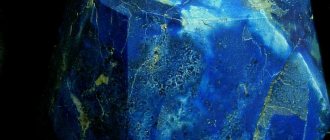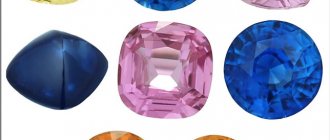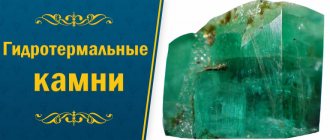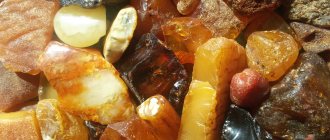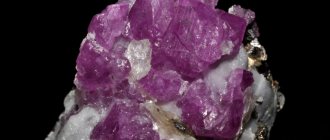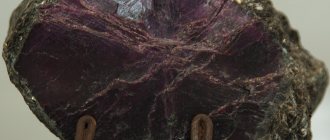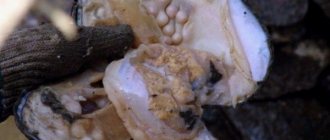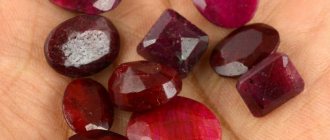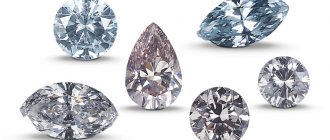| Category | Oxides |
| Title in English | Ruby |
| Formula | Al2O3 |
| Group | Corundum group |
| Color | Red, Red-brown, Red-purple, Red-pink |
| Stroke color | White |
| Shine | Glass |
| Transparency | Transparent |
| singonia | Trigonal |
| Hardness | 9 |
| Cleavage | Imperfect |
| Density, g/cm³ | 3,99 — 4,10 |
| Kink | Conchoidal |
| origin of name | The name for this corundum was created from the Latin word rubens or also rubinus, which translates as blushing. |
Ruby is a variety of corundum, namely aluminum (III) oxide with chromium impurities, which gives it an unusual red hue. Artificial ruby was first synthesized by the French chemist O. Verneuil in 1904. Rubies have found use in the jewelry and watch industries, as well as in quantum electronics.
Ruby deposits
Deposits of this precious stone are located on all continents, with the exception of Antarctica.
The most ancient of them were discovered in the Pamirs (Snezhnoye, Tajikistan). — Advertising —
The main modern exporting countries are Myanmar, Thailand and Sri Lanka. Rubies found in eastern Africa (Kenya, Tanzania) are also of good quality.
As an accompanying material, rubies are found in the south of the Urals, in the north of Karelia, and on the Kola Peninsula.
ORIGIN
Ruby crystals, 1.3 cm, Russia, North Karelia, Loukhsky district, Hit Island
Primary deposits are in crystalline marbleized limestones, plagioclasites and mica, which developed over ultrabasic rocks. Sometimes found in alumina-rich and silica-poor deep igneous rocks - corundum syenites and anorthosites in association with feldspars, occasionally in other rocks (andesites, basalts, etc.). Corundum-containing syenite pegmatites of industrial importance are also known. Contact-metasomatic corundum deposits are formed in crystalline limestones adjacent to igneous rocks. The main deposits of rubies are located in Myanmar (Mogok), Thailand, Sri Lanka (Ratnapura), Afghanistan (Jegdalek), Kenya and Tanzania (upper reaches of the Umba River). The bulk of precious varieties are found in placers. Since ancient times, it has been mined in the Pamirs along with pink spinel (Kukhilal deposit, Tajikistan. In Russia it is noted in the Urals (Rai-Iz, Pol. Ural; Murzinka, Middle Ural, etc.)
Ruby history
During the Middle Ages in Rus', rubies were not distinguished from sapphires and both stones were called “yakhonts”.
The phonetic path of this word began with the Greek “yaksintos”, which passed into the Persian “yakund”, then into the Arabic “yakut” and the Slavic “yakhont”. And the word "ruby" comes from the Latin "rubeus", which refers to its red color. Rubies have been known to man for a very long time; they were mined in Burma during the Bronze Age. These stones were valued and used as talismans in Ancient India, Greece and Rome. Thus, in the main temple of the ancient Greek city of Hierapolis there was a gilded statue of Zeus’s wife, Hera, decorated with large rubies. In the Middle Ages, rubies were recognized as a symbol of Fire, and the sun was considered its patron.
— Advertising —
A related line of rubies and sapphires was discovered in 1800 in Europe. And in 1960, scientists first created a solid-state laser using this stone.
Artificial cultivation of stones
Synthetic corundum, namely artificially grown sapphires and rubies, appeared on the jewelry market at the beginning of the last century. They owe their appearance to the scientist Verneuil, who made a furnace to create a flame from oxygen and hydrogen. By passing aluminum with a small amount of substances through such a flame, he obtained some crystals shaped like bullets. Thanks to this process, it became possible to create large minerals in a short period of time.
But because this process takes much less time than the natural process, the rubies harden, forming curved lines. They can be noticed during stone processing and they will definitely indicate artificial rubies. Upon careful examination, you can also notice small gas bubbles that are uncharacteristic of rubies.
Of course, synthetic rubies are much cheaper than their counterparts, but mainly due to their rarity. They practically do not differ in properties from natural ones and therefore are widely used. In this regard, there was an interesting incident in history.
Several years before the first synthetic ruby was created, a ruby necklace made by the famous craftsman Melillo was sold at auction. It was decorated with incredibly beautiful rubies, which, as it turned out later, were artificial. There were no signs of substitution. It is still not known for certain whether the product was made directly from synthetic stones, and whether the master knew about it.
Record ruby
Some of the largest and most beautiful rubies were mined in Myanmar near Mogok.
Large rubies are a rare occurrence; even a weight of 35-40 carats is unique for them. One of the largest Indian rubies weighed 951 carats. The Sun of Mogok (1,743 carats) and Navara Ruby (504.5) rubies are kept in Myanmar. The Los Angeles Historical Museum protects the Nixon Ruby stone (196 carats). A record price ($30 million) ruby with a pigeon's blood color and weighing 25.59 carats was sold at Sotheby's auction in 2015.
Physico-chemical characteristics of ruby
Ruby is basically corundum, aluminum (III) oxide.
Its color is due to the presence of chromium, ferum, and titanium in the mineral and varies from red, pink-red to purple-red of varying degrees of saturation. The stone is translucent, transparent, with shine. In terms of hardness - second place after diamond, on the Mohs scale - 9. It does not have cleavage, which is why it is resistant to breaking and mechanical stress. The fracture is conchoidal and uneven.
The syngony of ruby is trigonal. Habit: hexagonal flat plates or columnar.
The density of the stone is from 3.97 to 4.05. Light refraction: 1.766-1.774.
Types of ruby
Typically, only red, richly colored corundums are considered rubies.
Pink varieties belong to the sapphire group. In nature, young stones of light pink or lilac color are rarely found. The color is directly related to the deposit, for example, Myanmar rubies are always bright red, occasionally with a lilac tint. A purple tint is typical for stones in Vietnam, while in Thailand the mineral has dark red or even brown shades.
An interesting variety is the star ruby with a beautiful six-pointed star in the center of the stone. Sometimes there is even a double star.
Ruby inclusions contain an anolite stone consisting of green zoisite. It is mined in Tanzania.
But the black ruby is not actually a ruby, it is a type of spinel.
Gradation by quality and price of rubies
The fiery red ruby is rightfully the epitome of perfection. Jewelry connoisseurs rate this stone quite highly. The cost of some large specimens sometimes exceeds the cost of diamonds of the same size.
Rubies are:
- red with dark and light shades;
- pink;
- scarlet;
- purple.
The precious crystal can have orange, purple and black glitter.
There are stones of amazing shape and color intensity. There are slightly cloudy specimens and opaque ones, star-shaped and with a cat's eye effect. Some types of crystals are not cut, but polished, giving them a convex shape. Burmese rubies are still famous for their particularly beautiful and expensive specimens. The price of one carat can start from 50 and reach 5,000 US dollars.
Indian corundums differ from stones from other deposits in their light shade and the presence of cracks and specks in the stone. Because of this, the cost of stones is much lower.
Tanzanian rubies are particularly dark and monochromatic. This classifies the mineral as second grade. But some stones have a bright garnet hue and after cutting, garnet rubies become worthy of attention.
Precious crystals from Kenya, Madagascar, and Afghanistan have amazing reflections and effects, although they are much less expensive.
Modern technologies make it possible to grow red corundum artificially. The resulting crystal is not inferior to natural ruby in appearance and quality. The synthetic mineral is widely used for industrial purposes. To distinguish a natural ruby from a man-made one, simply dip it in milk - the surface turns pink.
Magic properties
Fire is the native element of rubies.
The stone protects its owner even in the midst of ill-wishers and makes him invulnerable. For this purpose, the ruby is worn on the body, hidden by clothing, and the amulet is not removed. But it is worth considering that the influence of the stone depends on the qualities of the person: thus, a ruby makes a kind, good owner noble and persistent in the pursuit of a goal, and only strengthens the negative character traits of evil people.
Rubies are responsible for leadership and responsibility, they help overcome complexes and lack of self-confidence, awaken love and craving for great things, arts, sciences, and military affairs.
Ruby also symbolizes passionate carnal love.
Ruby Magic
This red gem is a stone of power. It has always been worn by people who have reached a high position, on whom the position of other people depends.
Esotericists have long believed that the magic of a ruby does not change a person. It only strengthens his character traits - both good and bad. Here the meaning of the stone is to be a catalyst for human qualities.
Ring with ruby
Therefore, a person with evil thoughts should not wear items made of red ruby. In this regard, the stone is “unprincipled”; it always indulges the passions of its owner. Whether it’s passionate love or the same passionate desire to ruin a rival by any means, to harm a rival... It’s better not to wish harm on your neighbors (and those far away too).
- Ruby is a stone of brilliance and vanity, pride and creative success.
- But these magical properties of the stone can energetically devastate the owner.
- Active, energetic people will find a harmonious ally in the gem.
- Ruby, its fiery color carries the symbolism of love, passion and fidelity.
- The magical properties of ruby protect the owner of the stone from evil forces and from astral attacks.
- If the color or shine of a gem has changed, this means you should be wary. These are signs of possible danger.
- Dedicated magicians love ruby - the stone gives them strength and power over the lower astral plane.
- Fire is the element of ruby. And the flames of passions are subject to the flame-colored stone.
- It is important to know that ruby is a symbol of love, but carnal love.
We recommend: RUBELLITE - favorite of emperors, pink tourmaline
Interesting: some esotericists believe that the property of the ruby (lonely) is to attract loneliness. That is why it is recommended to wear rubies in pairs.
All properties apply only to real gems.
Applications
As a category I gemstone, ruby is used to make expensive jewelry.
Synthetic ruby is used for inexpensive products and watch movements. It was also used in 1960 as the light-emitting active medium in Theodore Maiman's first laser, and has been used in that direction ever since.
Jewelry
Rubies are inserted into earrings, rings, rings, and they are used to make necklaces and chokers. Flawless in silver. A ring or set will fit into any look and style (except sports). Red corundum is suitable for both blondes and brunettes.
The ruby set, belonging to the Danish royal court, was made in the 18th century, and since then has been passed on to new representatives of the dynasty, occasionally replenished with fresh items.
For everyday wear, choose a thin ring with a compact stone; for evening wear, massive jewelry with large dark rubies is suitable.
It is very appropriate to give a gold ring with a ruby for engagement. Without further ado, it will tell the chosen one about the passionate love and devotion of the donor.
How to choose a ruby
When making a purchase, they take into account the place where the mineral was mined, its color, clarity, type of cut, and whether the stone has been improved. Heat treatment enhances the color, making an otherwise dull stone appear brighter and more attractive. However, you need to know that heated crystals are much cheaper than unheated crystals of the same type.
Natural ruby, being a popular gemstone, is counterfeited. For this, glass or plastic is used. Fake stones should not be confused with synthetic and refined ones.
Each unprocessed precious “pigeon’s blood” ruby goes into the collections of the richest collectors and museums, since it costs fabulous money.
A product with a small ruby can be freely purchased in a retail store from $27 in the form of a silver ring, to $620 for a stone set in gold. Gold earrings with a gem - from 33 to 120 dollars.
A natural ruby of jewelry quality, for example, from Burma, the Mogok deposit, weighing from 1 carat costs from 1 to 30 thousand dollars, because Pure stones with rich colors are extremely rare.
Products with semi-precious rubies are priced lower. For example, a pendant with a Burmese ruby - from $17.
According to the law, artificial stones cannot be considered precious, even if they have the properties of the latter. However, rubies available in stores have mostly been crack-filled with lead or beryllium glass. When purchasing, ask for a certificate!
How to wear and care for products
Considering that a gemstone is not just a decoration, it is important to interact with it correctly so that it helps.
It matters which finger you wear the ruby ring on. Women traditionally wear the passionate love stone on their ring finger. If they find a place for him in the middle, they reduce their sexuality. A gold or platinum ring with a ruby will help you get rid of worries and strengthen your faith in your own strength. An excellent addition to the ring is a gold pendant with a ruby in the form of a drop. Such a set would be appropriate for an important celebration.
A man's ring with a ruby is worn on the middle finger and also worn on the ring finger. Decoration confidently leads a person to victories in life, helps a leader wisely manage a team, and teaches compassion. Men's gold jewelry with red corundum is an excellent anniversary gift.
It is important to follow the rules for wearing jewelry. Wear a bracelet or ring on your left hand if the goal is to achieve positive changes in your personal life, and on your right hand if you want to achieve success in your career.
A precious ruby requires careful attention. Before putting on a ring or earrings, stroke the stone, say a kind word, ask for help, like a friend. The gem will certainly respond.
The attractiveness and brilliance of a ruby will last for decades if you care for it properly:
- store in a separate box;
- do not keep in the sun;
- do not heat;
- avoid contact with sharp objects, household chemicals, cosmetics;
- clean with a soft toothbrush in soapy water or wipe with a product for precious metals;
- monthly cleanse the crystal of negativity by placing it under cold running water for a while. Just be careful not to let the decoration go down the drain.
A careful attitude will allow you to turn an expensive piece of jewelry into a family heirloom.
Ruby colors
Based on color, rubies are divided into the following groups:
- bright red;
- red;
- medium red;
- dark red;
- light red.
The less chromium it contains, the paler the color.
The most valuable shade is the color of pigeon blood, which combines purple and violet shades.
Ruby processing options
Gem enhancement is carried out in several ways:
- heat treatment is necessary to eliminate purple and orange tints, as well as to remove rutile microfibers to improve the visual perception of the jewelry;
- the use of a flux medium makes it possible to “heal” open cracks;
- the use of diffuse processing using a beryllium layer allows you to give the ruby a rich red color;
- filling large cracks with a special glass composition improves color and clarity, but reduces the cost of the gem;
- surface coloring is necessary to change the color characteristics (rarely used in jewelry).
All varieties of ruby are subjected to heat treatment and cutting. Only after processing can the gem be set in gold rings, necklaces, chokers and other jewelry.
Ruby purity and its definition
Finding a perfectly pure ruby without defects or inclusions is not an easy task.
But some of the possible inclusions have a positive effect and increase the price of the stone. These include inclusions that form a six-pointed symmetrical star in the center of the ruby. Such specimens are very rare. Other inclusions reduce the transparency and brilliance of the stone. According to purity, rubies are distinguished:
- Very clean shiny stones with sparse and small dots and stripes;
- Almost pure, shiny, interspersed with foreign minerals, stripes and cracks;
- Opaque with cloudiness in some areas.
Purity assessment is carried out in special laboratory conditions. Transparent, deep red rubies with a violet tint are recognized as the most valuable.
Colors and varieties
The most common color is red, but there are others.
The most common type of stone, of course, is the red ruby, the color of wine or blood. A gem can also be:
- fiery golden;
- red-brown;
- pink - stones of this shade are often confused with spinel.
The most valuable variety of ruby is the so-called “pigeon blood”, a gem with a purple or bluish tint. Despite the fact that the stone is similar in composition to sapphire, it cannot boast such a variety of shades.
Star ruby is also highly prized. Its edges form a unique pattern. If you shine a light on them, you will notice that a six-rayed star is burning in the center of the stone. They said about such rare corundums that they were the work of powerful sorcerers of antiquity, who could enclose stars from the sky in their magic crystals.
Another interesting rock is called anionite. It contains elements of pinkish ruby and zoisite, its green relative. Together they form a crystal with a unique design that any jeweler will happily take on.
Artificial ruby
For the first time, synthetic ruby began to be grown artificially in industrial conditions and is widely used instead of natural ruby for jewelry and technical purposes.
Immediately after extraction, stones are thermally treated, which changes their natural structure; such stones occupy about 4% of the market. They are also created using beryllium dyeing, which makes corundums deep red (1% of the market). The remaining 95% are glass-filled specimens. Their cost is no more than $30 per carat, the price for heat-treated specimens without glass starts from $100 per carat, natural rubies are priced from $500 per carat.
Features of ruby mining
Extraction of minerals is carried out manually. The method remains the same as hundreds of years ago.
The disadvantage of this method is that there is a very high probability of damaging or destroying the ruby. The work requires serious physical effort. But first, a person must obtain a special permit, which is very expensive.
Mining stages:
- Determining suitable terrain. In most cases, people prefer scattering.
- Organization of mines with installation of special equipment for pumping water.
- Excavation of rock, which in most cases is clay. After extraction, the minerals are purified.
This extraction method is not only inconvenient, but also extremely dangerous. Not every person is able to do such colossal work to get a ruby. It is quite difficult to determine the volume of extraction, so individual specialists are hired for the work.
Mining ruby is a very difficult job, taking place in rocks at a depth of up to 30 m. But for many people, this is the only way to survive and earn money.
How to distinguish a real ruby from a fake one
It is quite difficult to distinguish a real ruby.
To do this, it is brought to the light. In bright light, a real stone darkens, but its color and shine remain even and uniform, while an artificial stone either does not change color or becomes lighter and has an uneven shine. An accurate result is obtained by testing using ultraviolet radiation: if the stone turns orange, then it is synthetic.
Also, fake stones break easily and may have even cracks. Cracks on real rubies have jagged, zigzag edges.
Natural ruby leaves scratches on turquoise and garnet, but artificial ruby does not. There are no bubbles in it, or they are the same color as the stone.
Twin stones
In order to choose a stone, you need to know how to determine the authenticity of a ruby. To do this, let’s figure out which stones are similar to rubies and how they differ.
1) Spinel. This stone can easily be confused with natural ruby; it has a very attractive appearance, but is very rarely used in products. It can be easily distinguished from a ruby using a refractometer, since its refractive index is 1.72. But if it is not possible to carry out an analysis with this device, other properties of spinel will help in how to distinguish a ruby.
The fact is that ruby has double refraction and exhibits dichroism, which spinel does not have. You can also distinguish the two stones by color: ruby has a raspberry tint, spinel has a strawberry tint. In addition, it exhibits fluorescence, like some rubies. It is characterized by inclusions resembling bubbles.
2) Tourmaline. Due to the fact that it is very similar to natural ruby, tourmaline also has another name - rubellite. But it can be easily recognized by its color. Tourmaline is characterized by a pinkish color, while ruby has a crimson hue. In addition, this can be done very simply using a refractometer, since its refractive index is about 1.63. It also does not have whitish inclusions of ruby.
3) Garnet is another gem from which natural ruby very often cannot be distinguished. The refractometer in this case can be misleading due to too close refractive indexes. Therefore, a dichroscope is used for this because garnet has a single refraction.
The closest color to ruby is pyrope garnet. To distinguish them, a spectroscope is used. Using such a device is not very easy, but you can notice the characteristic almandine absorption stripes that are characteristic of garnets.
4) Red rhinestones. It is very easy to distinguish red rhinestones from rubies; just take a magnifying glass and look for light funnels or gas bubbles.
How to care for a ruby
Rubies are stored in dark, cool places, as this gem does not like prolonged exposure to the sun.
Jewelry with rubies is wrapped in soft cloth and stored separately. To clean such jewelry, heat water, stir soap in it, and lower the accessory there for half an hour. Then wipe it with a toothbrush with soft bristles. The solution is washed off and the stone is wiped dry with a soft cloth.
Jewelry with rubies is worn after applying makeup to prevent particles of makeup from getting on the stone.
Ruby and zodiac signs
The zodiac sign for ruby is Leo.
It is also recommended for Sagittarius. Virgo and Taurus, as well as Cancer and Scorpio should not wear the stone. Ruby is associated with the element of Fire. In its owner it “awakens” passionate character traits: courage, mercy, will, determination and activity. But the stone can also enhance a person’s natural negative traits, which is important to consider when choosing it.
Medicinal properties
Modern lithotherapists have described the following healing capabilities of ruby:
- improving the functioning of the immune system;
- wound healing;
- improving blood flow, heart function, improving blood pressure, toning blood vessels;
- improvement of brain functions;
- sedative for stress or depression;
- assistance in the treatment of paralysis, epilepsy, schizophrenia;
- treatment of joint diseases;
- elimination of problems of the digestive system, in particular, treatment of stomach ulcers.
Ruby is considered a hemostatic agent. It also has an antipyretic effect, relieves bad dreams, cures chronic tonsillitis, diseases of the kidneys, liver and spine.
Did you know that medieval Aesculapians used ruby to treat the plague?
A sunbeam passed through a ruby is endowed with healing powers. Healers claim that such light has a positive effect on metabolism, restores tissue, and has an anti-inflammatory effect.
It is important! People suffering from hypertension (high blood pressure) or blood incoagulability (hemophilia) are contraindicated from wearing a ruby!
Ruby-charged water is an effective way to maintain beauty and health. To do this, leave the gem in water overnight, and then drink the liquid or wash it with it. This technique helps to quickly recover from stress, restore strength after illness, or simply maintain natural beauty.
Prices for ruby products
A natural red ruby is very rare and is expensive.
For example, a 5-carat “pigeon’s blood” ruby is valued at $50,000 per carat. But finding such a stone is even more difficult than a 5-15 carat diamond. The main ruby market is located in Asia, in Rangoon (Myanmar). Thus, a 38-carat ruby was sold at auction for $5,860,000. After cutting, the stone weighed 25 carats, and the stone was sold for $12,000,000.
A 5-carat heat-treated “pigeon's blood” ruby costs between $8,000 and $10,000 per carat.
In general, the price depends on the presence of cracks, darkening and bubbles, and the shape of the stone cut.
How a ruby is cut
There are technical conditions for processing rubies. The shape of the cut is determined by the shape of the girdle.
We recommend: FIRE OPAL - incredible colors of sunstone
Traditional cut shapes:
- round;
- oval;
- rectangular;
- square;
- antique;
- emerald;
- marquis;
- pear;
- heart;
- fantasy.
Cabochons are cut with a flat or convex pavilion.
Interesting facts about ruby:
- There are deposits of rubies everywhere, except in Antarctica, but, nevertheless, a real stone is rare.
- Opaque rubies of the lowest quality are polished with an appropriate cabochon, after which a six-pointed star is sometimes found on them - an unusually beautiful optical effect.
- Of all the precious stones in the Bible, the most frequently mentioned is the ruby.
- The black stones on the crown of the British Empire are called the Black Prince and Timur rubies, but they are spinel.
- In ancient times, rubies were placed in the foundations of buildings to make them strong and strong.
- The famous ring from the J.R.R. trilogy was inlaid with rubies. Tolkien, as well as the sword of Godric Gryffindor in the Harry Potter series of books (Joan Rowling).
